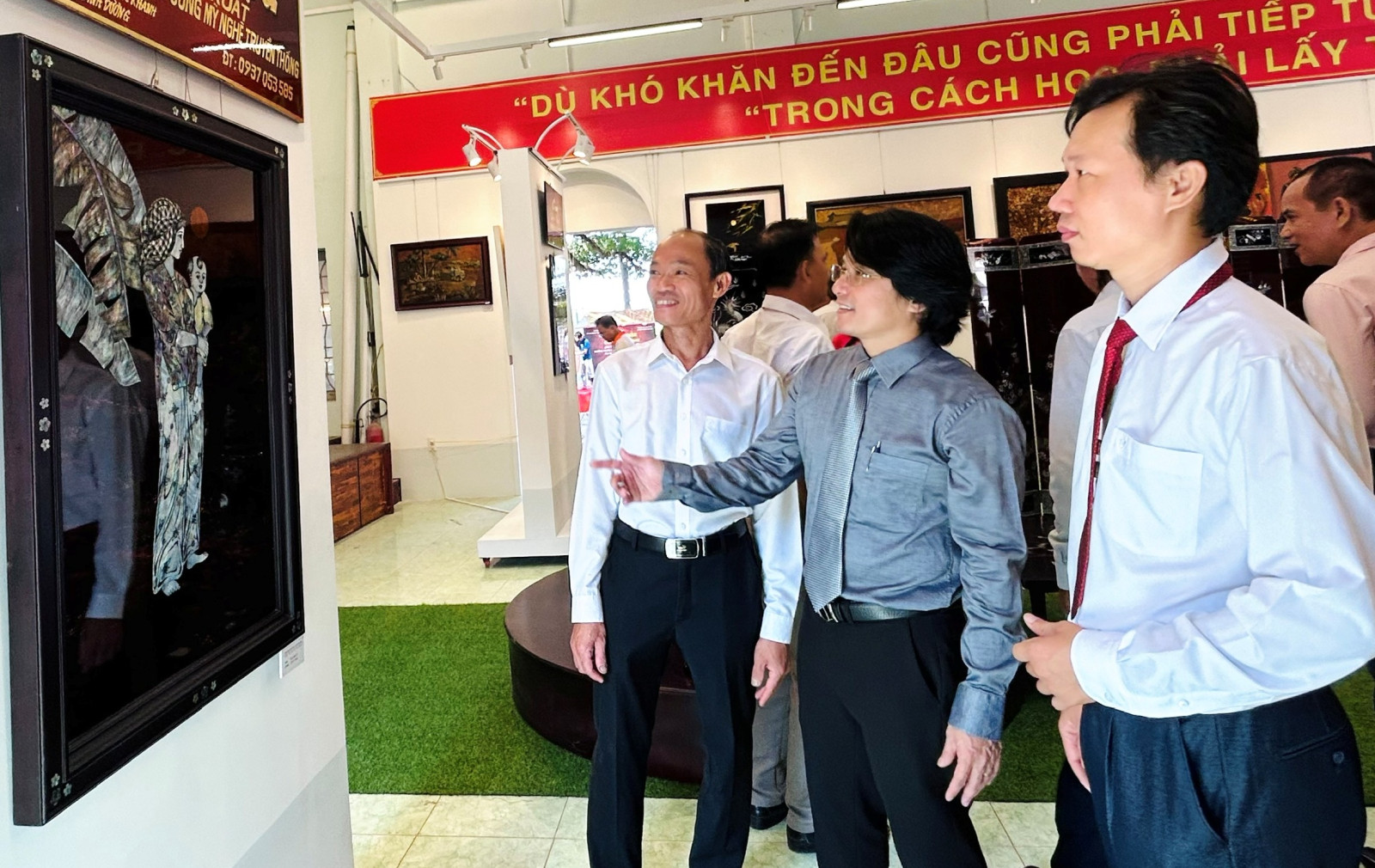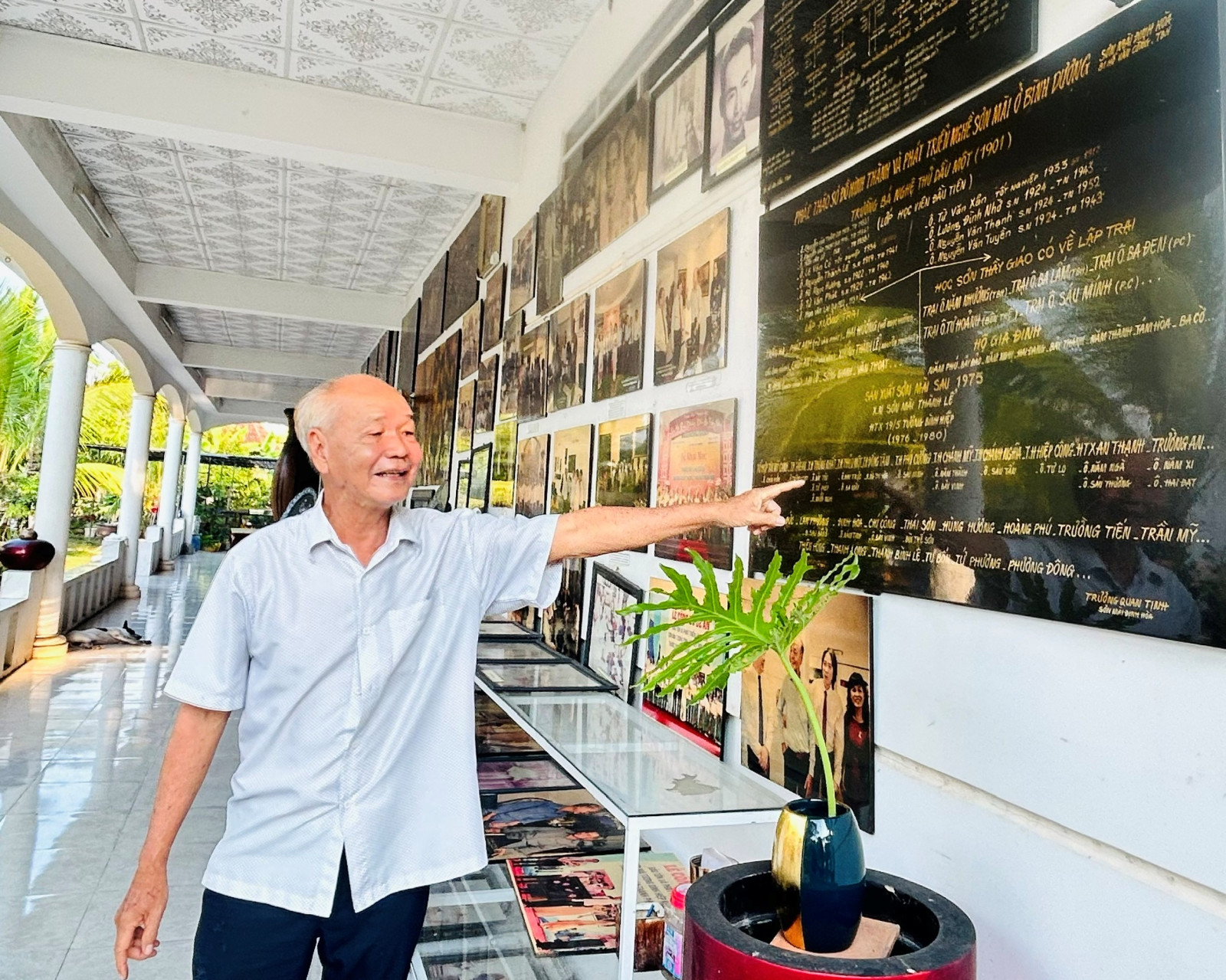Lacquer of Binh Duong preserves its values
Not only is Binh Duong developing rapidly and strongly in industry, it is also known for many traditional handicrafts that have existed for hundreds of years. Handicraft products created by generations of talented artisans and workers in Binh Duong are welcomed by domestic and foreign customers, including products from Tuong Binh Hiep lacquer craft village, Thu Dau Mot city.
Delegates visit Binh Duong lacquer exhibition at Binh Duong College of Fine Arts and Culture
The traditional values preserved and passed on
According to documents from Binh Duong provincial Museum, the lacquer craft in Binh Duong was brought to the new land by Vietnamese immigrants from the North and Central regions during the process of reclaiming land and establishing settlements. The process of forming the lacquer craft in Binh Duong province is similar to and closely linked to the process of forming the local Vietnamese community.
For hundreds of years, the lacquer craft in Binh Duong province has always been practiced and passed down by generations of artisans and workers. Mr. Le Van Phuoc, Director of the Provincial Museum, said that according to some artisans, around the end of the 1930s of the 20th century, Mr. Nam Nhuong and Mr. Ba Lam, after finishing the lacquer craft class at Thu Dau Mot Practical Arts School (now Binh Duong College of Fine Arts and Culture), returned to the village to open a lacquer workshop. Then, around the end of the 1940s, Mr. Le Van Co (often called teacher Co, or teacher Son) also returned to the village to teach the craft to his children and the young people in the village. Just like that, the lacquer technique in Tuong Binh Hiep - Binh Duong has been passed down from generation to generation by artisans.
Through ups and downs and facing competition from many products of other industries in the market, lacquer products are still preserved and passed down to the next generation by generations of craftsmen in this land.
The peak of the Tuong Binh Hiep lacquer craft was in the 1980s and 1990s with over 400 households producing lacquer and more than 90% of residents participating in the craft. However, in the past few decades, the Tuong Binh Hiep lacquer village in particular and the traditional lacquer craft in Binh Duong in general have tended to decline sharply.
Compared to its peak, the lacquer craft in Tuong Binh Hiep ward is now operating quite modestly. Meritorious artisan (elite artisan) Truong Quan Tinh, one of the veterans who has been associated with lacquer for many years, said that during the heyday of lacquer in Tuong Binh Hiep, "Every family made lacquer, every person made lacquer".
Despite competition, although the number of production facilities and the workforce has decreased significantly compared to the peak, the lacquer craft still exists, lacquer products are still welcomed by customers because of their uniqueness. Thanks to the support of machines, the number of products made is large and exported abroad, proving that the lacquer craft in Tuong Binh Hiep in particular, and Binh Duong province in general, still has a place in the international market. According to some artisans who have been involved in the lacquer craft for many years here, they can still make a living from their profession, and even thanks to this profession, their lives are getting better.
From painters to lacquer crafters
Lacquer craft is considered as a ladder following the painting craft (also known as the lacquerware craft). Meritorious artisan Truong Quan Tinh said that at first, the lacquer craft in Tuong Binh Hiep village was just a side job, for people who had the profession took advantage of making lacquerware during the off-season to create household items. By the end of the 19th century when life gradually stabilized, people began to focus on building large houses to live in, building religious facilities for worship. Thereon, the carpentry profession had the conditions to develop and the painters also had more work to do. From being a side job done in their spare time, many painters switched to their main job, they combined with carpenters to paint architectural works, wooden furniture, and gilded lacquer to make wooden products look more beautiful and durable. In addition, Tuong Binh Hiep painters also proactively created products for decoration, applied in families, pagodas, and temples.
|
Lacquer craft in Tuong Binh Hiep, Binh Duong is famous for its elaborate manufacturing process, the production stages are carried out meticulously, ensuring both technical and aesthetic factors. According to the excellent artisan Truong Quan Tinh, the traditional lacquer production process must go through more than 12 layers of paint and over 25 stages. In the traditional lacquer production process, the main raw material used is lacquer. It takes a lot of time to complete a product, about 3 to 6 months.
Meritorious artisan Truong Quan Tinh introduces the traditional lacquer production process and the diagram of formation and development of lacquer craft in Binh Duong |
The lacquered products have shiny and smooth colors, with beautiful decorative themes and are close to human life, so they are favored by customers. The demand for lacquered products is increasing while the workforce is needed; the painters are teaching family members to increase their income.
Tuong Binh Hiep lacquer craft, from being a private individual activity, gradually expanded to a household scale and gradually formed a bustling traditional craft village.
After 1930, a number of students from the Indochina Fine Arts College (now the Vietnam University of Fine Arts) such as Tran Van Can, Tran Quang Tran, Pham Hau, Nguyen Khang, Nguyen Gia Tri, To Ngoc Van among others together with artisan Dinh Van Thanh successfully researched a type of lacquer that can be polished with water. Lacquer is prepared by mixing raw lacquer with rosin in a certain ratio, used to mix with paint or cover the surface and then polish with water to make the product more durable and beautiful. From traditional lacquer techniques to artistic lacquer is a major turning point in the history of the development of Vietnamese lacquer, contributing to the formation of a new craft based on the traditional lacquer craft - that is lacquer craft in Vietnam.
From the Indochina Fine Arts School, lacquer art quickly spread to traditional lacquer villages from North to South. People call lacquer products using lacquer techniques lacquer products (lacquer paintings, lacquer statues, lacquer vases, etc.) to distinguish them from the gilded lacquer products of the traditional lacquer craft. Many traditional Vietnamese lacquer craft villages including Tuong Binh Hiep lacquer village in Binh Duong province have gradually switched to making lacquer products.
With a long history of formation and development, the lacquer craft in Tuong Binh Hiep is considered a valuable art asset, expressing the cultural identity of the locality. According to the Director of the provincial Museum, Le Van Phuoc, Tuong Binh Hiep lacquer always contains very unique characteristics from the history of formation, materials to production stages. All of them show unique features, difficult to mix with other lacquer villages across the country.
Reported by Hong Thuan – Translated by Vi Bao



